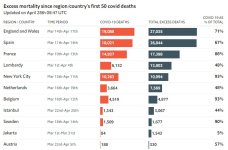Several remdesivir trial results are out today! "Remdesivir" was translated into Chinese by many investors as "people's hope", and Bruce Aylward, WHO's expert team head who led investigation in China, said "There is only one drug right now that we think may have real efficacy and that's remdesivir". I think I've discussed previously that antivirals like remdesivir may work at early stage and it may not work for later stage when dyfunction of multiple organs occurs. Now with more trial results, I guess it is time to believe what you believe lol
Double-blinded, placebo-controlled (2:1) trial on 237 severe patients in China
https://www.thelancet.com/journals/lancet/article/PIIS0140-6736(20)31022-9/fulltext
Editor’s Pick: In the absence of any known treatment for COVID-19, remdesivir is one of a handful of experimental drugs undergoing clinical trials worldwide. An Article, published in The Lancet, is the first randomised trial of remdesivir and suggests the antiviral drug does not speed recovery from COVID-19 in critically ill patients. However, while not statistically significant, pre-specified secondary outcomes suggest that time to clinical improvement and duration of invasive mechanical ventilation were shorter in people treated with remdesivir.
28-day mortality was similar between the two groups (22 [14%] died in the remdesivir group vs 10 (13%) in the placebo group; difference 1·1% [95% CI −8·1 to 10·3]).
Double-blinded, placebo-controlled trial by NIAID. 1063 patients (not only severe ones according to trial registration info)
https://www.niaid.nih.gov/news-even...esivir-accelerates-recovery-advanced-covid-19
Preliminary results indicate that patients who received remdesivir had a 31% faster time to recovery than those who received placebo (p<0.001). Specifically, the median time to recovery was 11 days for patients treated with remdesivir compared with 15 days for those who received placebo. Results also suggested a survival benefit, with a mortality rate of 8.0% for the group receiving remdesivir versus 11.6% for the placebo group (p=0.059).
Two dose comparison in severe patients by Gilead (no placebo or standard of care control)
https://www.gilead.com/news-and-pre...l-remdesivir-in-patients-with-severe-covid-19
Clinical outcomes varied by geography. Outside of Italy, the overall mortality rate at Day 14 was 7 percent (n=23/320) across both treatment groups, with 64 percent (n=205/320) of patients experiencing clinical improvement at Day 14 and 61 percent (n=196/320) of patients discharged from the hospital.
They didn't explain why Italy is different and why they looked at morality at Day 14 (I guess they are aware that the course of COVID is long): 5-day group 8% (16/200), 10-day group 11% (21/197), outside Italy 7% (23/320), in Italy 18% (14/77)












